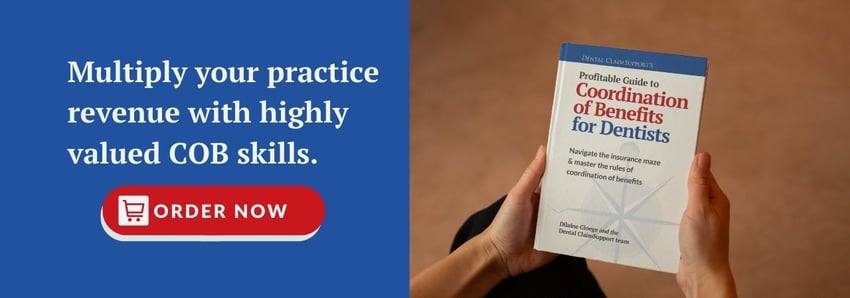Your Coordination of Benefits (COB) skills are valuable to your dental team


For any dental practice, the biggest roadblock to receiving full income is the cumbersome insurance billing process. How to calculate patient financial responsibility? Knowing what you should collect gets even harder when the patient has coverage under multiple plans. That’s when your dental insurance coordination of benefits (COB) knowledge is so valuable.
It wasn’t always so hard. Many years ago, the dentist filed a claim and the claim was paid by the patient’s insurance plan. It was simple. Most employers offered dental benefits to their employees and their families. If no insurance was offered by an employer, a patient was self-pay. That is not true today. There are many options for patients to obtain dental insurance in addition to an employer-sponsored plan.
In this article we will explain how understanding coordination of benefits can help your dental team calculate patient payments correctly.
Using Coordination of Benefits to calculate patients' out-of-pocket expenses
Preferred Provider Organizations (PPOs) also became a part of the dental benefit mix. When the doctor is in-network with a PPO, a mutually-agreed upon fee schedule applies. The PPO fee schedule determines the total patient financial responsibility, and the dental care provider agrees to not bill the patient for more than the agreed-upon PPO fee.
Sounds simple, right? Well, unfortunately it isn’t quite that simple, especially when you throw multiple plans in the mix.
The order of benefits (primary, secondary, etc.) does not determine the total patient financial responsibility. Simply put, it’s a myth to say that the in-network fee of primary is always the patient's financial responsibility.
By understanding COB and how to calculate the patient’s total financial responsibility, the doctor can reduce or in some instances, eliminate the PPO write-off when there is more than one plan. So, yes, understanding COB is crucial to practice profitability. Let’s look at a couple of examples.

Example #1 - A smaller write-off due to coverage from a secondary plan
The patient has two plans: On the primary plan, the doctor is in-network and on the secondary plan, the doctor is out-of-network.
$1,000 total fee submitted for a crown
$ 400 primary PPO allowed fee (this is the total patient responsibility)
$ 200 total primary paid
$ 500 total secondary paid
$ 700 total paid by both plans
The patient owes $0 because the patient's total responsibility of $400 has been satisfied due to coordination of benefits by secondary. The provider write-off is $300.
The practice can keep any amount received by all plans up to the full fee submitted, which in this example reduced the provider write-off by $300. If there had been no other insurance benefits, then the provider write off would have been $600.
Example #2 - A larger write-off due to no payment from secondary insurance
The patient has two plans On the primary plan, the doctor is in-network and the secondary plan is out-of-network.
$1,000 total fee submitted for a crown
$ 600 primary PPO allowed fee (this is the total patient responsibility)
$ 300 total primary paid
$ 0 total secondary paid
$ 300 total paid by both plans
The patient owes $300 because the patient's total responsibility of $600 has not been satisfied. The provider write-off is $400. For this example, the secondary plan has what is known as a non-duplication of benefits rule.
This means that if the primary plan pays the same or greater than the secondary plan would have if it were primary then secondary will pay $0.
These are just two of many examples. There are exceptions, such as if one of the plans is a supplemental plan such as AFLAC®, or if the plans are federal plans and one is a FEDHB plan.
Determining the correct COB rule is daunting at times. It is important to contact all plans the patient is covered under to confirm the COB rule for each plan before any claims are submitted. The practice is required to file claims in order according to the established COB rules of the plan.
Be sure you are calculating the PPO write-off and patient responsibility correctly to ensure the patient is not receiving a “false credit” on the account that actually belongs to the practice.
Coordinating benefits correctly makes you a valuable expert in your dental office
Your COB knowledge helps your practice collect all it can. Build this knowledge as a member of the Dental Claims Academy to learn how to optimize this information. Find out more about dental billing training for you or your team.
You can also participate in our Dental Claims Academy live, educational webinars once a month where we cover all things insurance regulations, CDT codes and more.
Related Posts
Dental revenue resources from Dental Claim Support

